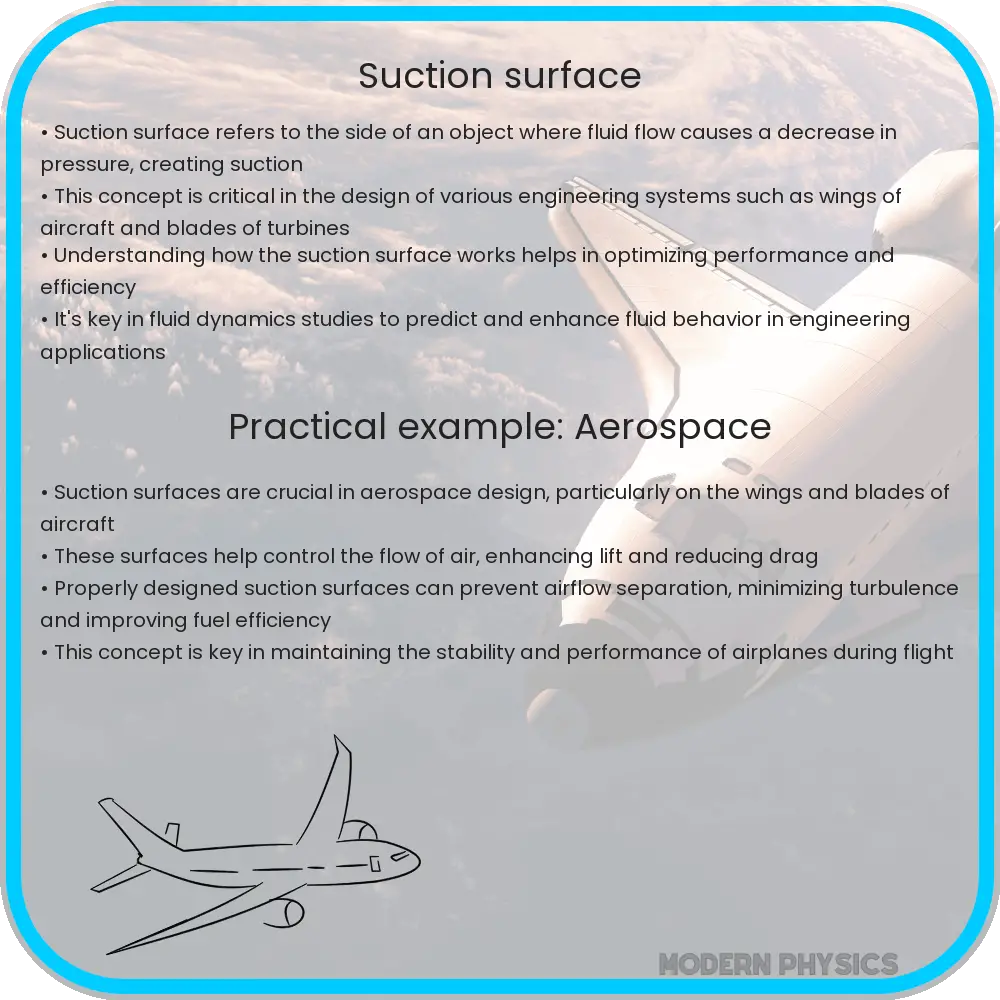Explore the role of the suction surface in hydrodynamics, crucial for enhancing fluid dynamics efficiency in engineering designs.

Understanding the Suction Surface in Hydrodynamics
In hydrodynamics, the concept of suction surface plays a critical role in the design and efficiency of various fluid flow systems, such as aircraft wings, turbine blades, and boat hulls. This article delves into the fundamentals of the suction surface, its implications on flow control, and its impact on efficiency in fluid dynamics.
What is the Suction Surface?
The suction surface refers to the side of an object that faces towards the flow of the fluid, usually experiencing lower pressure as compared to the opposite side, known as the pressure surface. In the context of an airfoil, such as an aircraft wing, the suction surface is the top side, which curves more than the bottom side. This curvature accelerates the flow of air horizontally, leading to a pressure decrease according to Bernoulli’s principle, which in simplistic terms, states that an increase in the speed of a fluid occurs simultaneously with a decrease in pressure.
Impact on Flow Control
The manipulation of the characteristics of the suction surface allows engineers to influence the behavior of the flow around an object. Such control is vital for achieving desired performances, such as lift in aircraft wings, or efficiency in turbines. By adjusting factors like the curvature, texture, or flexibility of the suction surface, the flow can be made smoother or more turbulent, which in turn affects the separation patterns and the overall dynamics of the fluid.
- Curvature: A higher curvature on the suction surface means the flow must travel a longer path, potentially increasing lift but also the risk of flow separation if the curve is too steep.
- Texture: Surface texture, such as dimples on a golf ball, can create a thin turbulent boundary layer that clings to the surface better and reduces drag.
- Flexibility: Flexible surfaces can adapt their shapes dynamically to optimize flow conditions throughout various phases of motion.
Enhancing Efficiency through Suction Surface Design
Efficiency in hydrodynamic systems is largely dependent on how well the suction surface is designed to minimize resistance and maximize the beneficial forces like lift or thrust. In aerodynamic terms, efficiency can be enhanced by ensuring that the airflow remains attached to the suction surface for as long as possible, reducing drag and preventing flow separation.
Design techniques include:
- Optimizing the thickness-to-chord ratio, which balances the wing’s structural integrity with aerodynamic efficiency.
- Incorporating advanced materials that can change shape in response to flow conditions.
- Using computational fluid dynamics (CFD) simulations to model and predict flow behaviors for different suction surface designs.
Each of these approaches requires a thorough understanding of fluid mechanics and material science, highlighting the multidisciplinary nature of designing effective suction surfaces in hydrodynamic systems.
Real-World Applications
The principles of the suction surface find applications in numerous fields. For instance, in the aerospace industry, the efficiency of aircraft is significantly influenced by how well the suction surface is designed to handle aerodynamic loads and control flow separation. Similarly, in marine engineering, the shape of a ship’s hull affects its ability to slice through water, directly correlating to fuel consumption and handling characteristics.
Technological Innovations and Future Trends
Technological advancements continue to push the boundaries of what is possible with suction surface designs. For example, the development of smart materials and adaptive structures allows real-time alterations in the suction surface’s curvature or texture, optimizing flow properties instantaneously depending on the current demands. These innovative solutions are pivotal in the advancement of sectors like renewable energy, where efficiency in wind turbine blades directly impacts power generation.
Looking ahead, the integration of AI and machine learning into hydrodynamic design processes could lead to more sophisticated and autonomously optimized solutions. These technologies could predict changes in environmental conditions or operational demands and adjust the suction surface dynamics accordingly, achieving unprecedented levels of efficiency and performance.
Conclusion
The concept of the suction surface is a cornerstone in hydrodynamics, offering deep insights into fluid mechanics and its practical applications in various industries. By understanding and manipulating the dynamics of suction surfaces, engineers can significantly enhance the efficiency and performance of fluid flow systems. From the curvature and texture to the flexibility and material properties, each aspect of the suction surface can be engineered to meet specific operational needs, contributing to advancements in aerospace, marine engineering, and beyond.
As we venture further into an era of technological innovation, the continual exploration and improvement of suction surface designs remain crucial. By embracing new materials, computational tools, and technologies like AI, future developments are poised not only to refine current systems but also to revolutionize the way we understand and utilize the principles of hydrodynamics for more sustainable and effective solutions.
